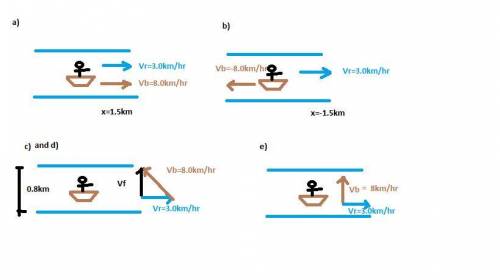
Physics, 01.10.2019 04:30 ayshearouse1203
Aboat can be rowed at 8.0 km/h in still water.
(a) how much time is required to row 1.5 km downstream in a river moving 3.0 km/h relative to the shore?
(b) how much time is required for the return trip?
(c) in what direction must the boat be aimed to row straight across the river?
(d) suppose the river is 0.8 km wide. what is the velocity of the boat with respect to earth and how much time is required to get to the opposite shore?
(e) suppose, instead, the boat is aimed straight across the river. how much time is required to get across and how far downstream is the boat when it reaches the opposite shore?

Answers: 3


Another question on Physics


Physics, 22.06.2019 08:00
While studying chemical reactions and conservation of matter, sarah's class conducted a variety of experiments. sarah and her lab partner found the mass of a wax candle and placed the candle in a flask. the students lit the candle and let it burn to completion. all that was left was wax and charred candle wick. per their teacher's instructions, the students found the mass of the products. their data can be seen in the data table. formulate a hypothesis the students could test to explain why the experiment did not support the law of conservation of matter. a) the students could repeat the experiment using different candles; there might have been a flaw in the candle. b) the experiment should be repeatable. the students should run several trials and then take an average of the after mass in each trial. c) the students should have someone in the class check their measurement skills as they repeat the experiment. they may have made an error using the balance. d) the students should burn the candle in a container that has some type of lid so that any gas that is a product of the reaction can be contained and massed. submit
Answers: 2

Physics, 22.06.2019 13:00
Nacidified solution was electrolyzed using copper electrodes. a constant current of 1.18 a caused the anode to lose 0.584 g after 1.52 ✕ 103 s. given that the charge of an electron is 1.6022 ✕ 10−19 c, calculate avogadro's number. assume that copper is oxidized to cu2+ ions.
Answers: 1

You know the right answer?
Aboat can be rowed at 8.0 km/h in still water.
(a) how much time is required to row 1.5 km do...
(a) how much time is required to row 1.5 km do...
Questions

Mathematics, 03.12.2020 19:40




History, 03.12.2020 19:40

Mathematics, 03.12.2020 19:40





Mathematics, 03.12.2020 19:40

Physics, 03.12.2020 19:40


Mathematics, 03.12.2020 19:40

History, 03.12.2020 19:40

History, 03.12.2020 19:40

Computers and Technology, 03.12.2020 19:40


English, 03.12.2020 19:40


 is the total velocity of the boat.
is the total velocity of the boat. is the the velcity of the boat relative to the water and
is the the velcity of the boat relative to the water and is the velocity of the river.
is the velocity of the river.























